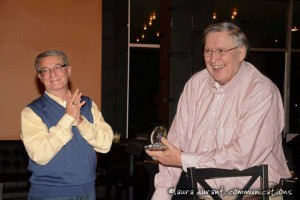Kyle Lawson (r) receiving the Actors Equity Award from Tony Hodges (photo by Laura Durant)
One of the most beloved and respected people in the arts & cultural community of Phoenix, Arizona is Kyle Lawson.
Beginning in 1977, and for more than 30 years, Kyle wrote about arts and entertainment in Arizona, first at the Scottsdale Progress, then The Phoenix Gazette, and finally The Arizona Republic. He was awarded the very first Lifetime Achievement Award by the Arizona Governor’s Commission on the Arts and a similar award from the Phoenix chapter of the Actors Equity Association.
To put it simply: when Kyle speaks people listen.
Yesterday, Kyle posted the following comments to his Facebook page. While the people named may only be familiar to those who have worked here in Arizona, the wisdom he shares is surely universal.
With Kyle Lawson’s gracious permission, I’m honored to share his comments:
————————————-
Just got off the phone with a college student who’s writing a paper on the working relationship between arts & entertainment journalists and public relations directors. Her basic question: Do journalists ever respect “flacks” (the student’s word, not mine)?It made me consider the 40 years I spent working with PR men and women. In my day, in many, perhaps most areas of journalism, there was a definite line drawn and it was seldom crossed. A reporter developed his or her own sources; any PR releases that came along were tossed in the nearest wastebasket.
Arts reporting was a little different. If you were a reporter for the New York Times, maybe you could call up Barbra Streisand and say “Hi, Babs, how’s Elliot Gould working out?” If anyone less august than a Times writer tried such an approach, well, you can only imagine the language. Like it or not, you had to go through publicity people.
Access was easier on the local level, but, still, if you wanted quality time with Childsplay’s David Saar or Phoenix Theatre’s Michael Barnard, or if you wanted to talk to Andrew Lloyd Weber ahead of the arrival of “The Phantom of the Opera” at Gammage, it helped to have a PR person around to facilitate the initial contact.
After that, let me emphasize, you were on your own, just as much as any political reporter or the guy who covered the cop beat. Yes, there were PR flakes. There were people who tried to manipulate you, who wanted to micromanage the interview, who liked to control their clients’ every response. God forgive me, that always brought out my nasty side. Those stories never ran – and I had my ways of letting the clients know why they didn’t.
The other side of the coin were the PR people whose sense of professionalism rivaled any journalist’s. I was lucky. I worked with a lot of those. Back in the late ’70s, I did my “training” under Jackie Thornhill, who was the publicist for the most interesting galleries, restaurants and individuals on the Valley’s cultural scene at the time.
She was tough as nails and defined the word “pro.” Jackie made it clear that, if I wanted help, she’d give it – but she wouldn’t do my homework for me. If I wanted a story, I had to dig for it. She never said “Don’t ask this,” “Don’t bring up that subject” or “Write it this way.” She simply said “Go for it,” then added “Don’t embarrass me.”
I can still see her, sitting sit back and chuckling while I tap-danced my way through the Q&A wars with a diva-ish gallery owner or a self-important artist. If I did well, she offered me a cigarette. I didn’t smoke, but I appreciated the honor.
Rosemary Walsh, whose work for Tempe’s Childsplay did much to gain that company a reputation as one of the nation’s finest theaters for young audiences, once told me that her job was to see I had what I needed to do my job and then let me do it. That said, she made a promise: Never to suggest something that wasn’t a really a story. “If the story isn’t any good,” she explained, “it won’t do Childsplay any good.”
I was so impressed with that comment, I wrote it down in my notebook, where it remains, heavily underlined, to this day. And, in truth, she never broke that promise – not even once.
There were other excellent PR people – the list is long and would be full of strangers to most of you – but if credit is ever given for Phoenix becoming a well-respected arts community, some of it must be shared with people like Laura Durant, Gary Bacal, Joe D’Nofrio, Michele Robins, Heather Scriven, Steve Carr, Carole Bartholomeaux, Pat Kennedy, David Harrison, Michael Rennie, Jen Spencer and their brothers and sisters who labored long and hard and never emerged from behind the scenes.
So, here is my answer to the student: Yes, though reporters and PR people live on different sides of an informational Divide, there can be respect. It should never be easily given; it should only be earned. But when it is there, stories are created.
Sometimes, even great ones.
# # #


Yes, But…
If only more reporters were like Kyle Lawson. I can’t tell you how many releases I have sent over the years, followed by interviews, followed by site visits to have the final article be the verbatim press release with a single quote added. The lazy attitude of most of the press is simply appalling and they often get the facts wrong even printing from the release. It is just frustrating that so much of journalist in the arts has fallen to such a low ebb.